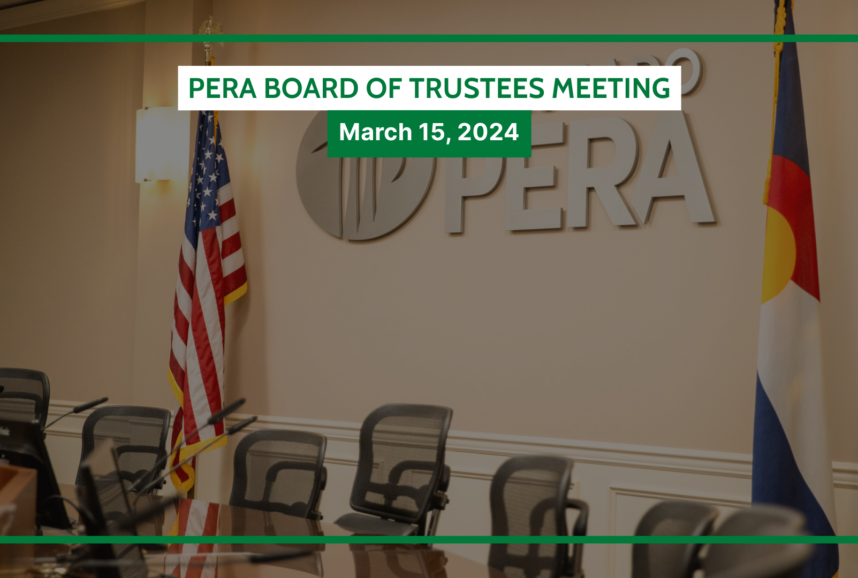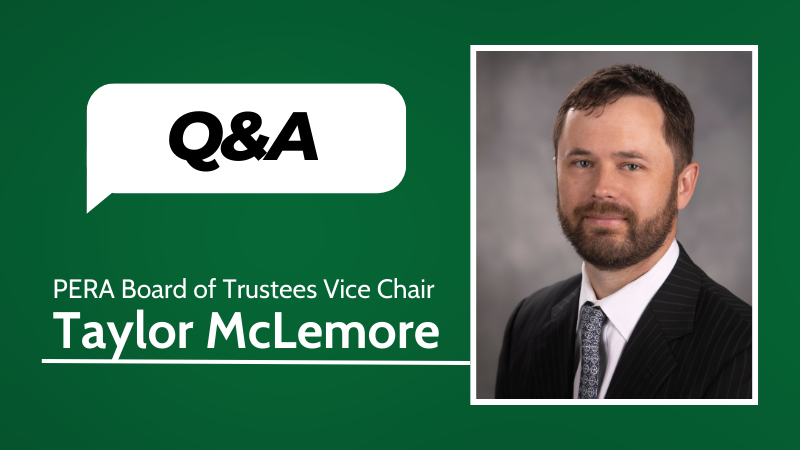On June 21, the Colorado PERA Board of Trustees released the 2018 Comprehensive Annual Financial Report (CAFR). The report includes 2018 information on PERA’s financials, including the funded status of the plan and the 2018 investment performance. The report, as well as an abbreviated interactive overview, is available on the PERA website.
For the year ending December 31, 2018, one of the major factors influencing the fund was passage of SB 18-200. This landmark legislation included major changes to the plan including provisions to help PERA stay on the path to reach full funding by 2047, even when there are departures from PERA’s core assumptions, including the investment return. When needed, these provisions will automatically trigger changes in contributions and annual increases.
For most investors, 2018 was a difficult year. For the year ending December 31, 2018, PERA’s investment portfolio returned a negative 3.5 percent, net of fees. Beyond economic conditions, changes in demographics also contributed to overall actuarial losses to the fund. The fund closed the year 2018 with a fiduciary net position of $45.2 billion, representing a $3.8 billion decrease compared with the year ending 2017. Over 30 years, the fund has increased the fiduciary net position by $37.2 billion.
The automatic adjustment is already working as intended: Last year’s investment losses coupled with demographic shifts mean that the automatic adjustment will be used in July 2020, adjusting member contributions, employer contributions, and the AI paid to retirees. Recall that SB 200 contained scheduled increases for members of 0.75 percent in July 2019 and 0.75 percent in July 2020. (Except for members in the Local Government Division.) In addition, the AI paid to retirees was suspended for the second year. Due to the automatic adjustment, member contributions will increase by an additional 0.5 percent in July 2020 and the AI paid to retirees will be set at a maximum of 1.25 percent. As such, starting in 2020, most members will contribute a total of 10 percent to PERA from each paycheck. The amount all employers contribute to PERA will also increase by one half of one percent in July 2020. Total employer contributions will range from 14.2 percent to 23.6 percent, depending on the Division, in addition to the $225 million direct distribution from the State of Colorado.
For more details, please see:
Colorado
PERA 2018 Financial Snapshot
Colorado PERA 2018 Comprehensive
Annual Financial Report Infographic
Colorado PERA 2018 Summary
Annual Financial Report
Colorado PERA 2018 Comprehensive
Annual Financial Report
FiduciaryA person who manages money on someone else’s behalf and who has a sworn responsibility to manage those funds in the best interest of the client.





Somehow I get the feeling that as a PERA retiree, I am never going to see another “annual increase.” Well, that’s the breaks. Maybe I should have known better than to think PERA could keep contracted promises with the kind of legislature and behind-the-scenes political manipulation that has turned out to be the case.
Dear Ms. Williams,
The Annual Increase in July 2020 will be 1.25 percent.
Agree Ms. Williams, and it’s not JUST the default on your (our) earned benefit of the annual increase….. it is, by the actions of PERA a real and tangible loss, a steady decrease in our earned benefit as inflation reduces the purchasing power of our pension.
This was severe fiduciary malpractice on the part of PERA and the state of Colorado. First to take an earned benefit from fully vested retirees , and now to actually lose 1.8 billion dollars in a bull market.
Phyllis thanks for your comments, but I think the go unheard at PERA.
Hi,
Thanks for the opportunity to comment. Why, with investment professionals on PERA staff are you so poorly making financial decisions to at least maintain PERA investment funds? My assessment of your financial management of PERA funds is simple, you just don’t have the skills needed to avoid losses and maintain some kind of gains.
My broker and other brokers I am familiar with through acquaintances, seem to not loose monies in 2018. Fire your financial staff with investment responsibility and find a large investment company to handle our monies. Your track record deserves a grade of F-.
WHO IN THEIR RIGHT MIND WOULD WANT TO GO INTO PUBLIC SERVICE WITH A RETIREMENT SYSTEM LIKE PERA.
RESPECTFUL;LY,
CAROLYN DE CAROLIS
Dear Ms. De Carolis,
Thank you for your comments. Global equities, as measured by the MSCI ACWI, declined 9.4 percent in 2018, while the Bloomberg Barclays U.S. Aggregate Bond index was flat for the year. (Recall that at the end of 2017, the PERA portfolio returned 18.1 percent.) The 10-year annualized rate of return was 8.8 percent at the end of 2018. The PERA portfolio is structured to balance risk and return over many decades.
We believe the PERA plan design remains a valuable recruitment and retention tool for PERA’s employers, and offers attractive benefits for Colorado’s public employees. You may wish to review this PERA on the Issues post that compares PERA to other public pensions around the country: https://www.peraontheissues.com/index.php/2017/11/01/colorado-pera-plan-design-compared-to-other-non-social-security-public-employee-retirement-plans/
Ms De Carolis has a good point:
Invest the funds with Vanguard Funds. As an example the Vanguard Wellington Fund has a one year return of 6.96%, 3-year return of 9.46%, 5-year return of 7.48%, 10-year return of 11.60%, and the return since inception in 1929 is 8.26
PERA should invest our retirement funds with Vanguard. As an example the Vanguard Wellington Fund has the following returns:
1-yr: 6.96%
3-yr: 9.46%
5-yr: 7.48%
10-yr: 11.60%
since inception in 1929: 8.26%
The fund is 65% stocks and 35% bonds. PERA can’t come close to these kind of returns.
5
Mr. Myers,
Thank you for this data. However, according to the Vanguard website, the Wellington Fund returned -3.42% in 2018.
https://investor.vanguard.com/mutual-funds/profile/performance/vwelx/cumulative-returns
A hypothetical 60 percent global equities/40 percent fixed income portfolio would have returned -5.9 percent in 2018.
Dear PERA,
Global equities, as measured by the MSCI ACWI, declined 7.4 percent in 2011; however, PERA still had a 1.9% return that year. In addition, the local government division’s amortization period was projected at 22 years. With 2018, global equities declined 9.6 percent (if I’m reading the chart correctly), and we had a negative 3.5 percent return, with the local government division’s amortization period now being projected at 37 years (a 15 year increase). With the economy doing so well, how can there be such a huge discrepancy between 2011 and 2018?
Dear Mr. Gatton,
In addition to investment return, there are two other very important components for determining the amortization periods of the trusts. 1) the demographic experience of the members in that trust (did payroll grow as assumed, did members retire when we thought they would, and other member behavior-related assumptions), and 2) the contributions received from members and their employers.
You may remember that employer and member contribution increases (via an increase in the AED and SAED) were part of SB 10-001. The Local Government Division and Judicial Division were exempt from these increases because they were better funded and had shorter amortization periods than the State and School Divisions. See the Comprehensive Annual Financial Report for details on member and employer contribution rates (see page 266 for Local Government Division information): https://www.copera.org/sites/default/files/documents/5-20-18.pdf
How can we have a met negative return when the economy and the stock market have been doing so well?
Dear Ms. Taylor,
During the fourth quarter of 2018, the decline in the stock market impacted the calendar year total fund return. A hypothetical portfolio of 60 percent global equities and 40 percent fixed income would have returned negative 5.9 percent during 2018.
Who are the culprits who were self serving them selves st the expense of retirees? Follow the money and I bet you find the crooks.
Paul thanks for your comments. Politicians and crooks are the same no mater party affiliations.
You morons make it more difficult to retire at a decent age. What were you idiots thinking when you were losing all that money?
With the sad news of 2018, what is 2019 looking like?
Dear Mr. Stegman,
It is too soon to know what investment return in 2019 will be. We have preliminary, unaudited investment return information as of March 31, 2019, here: https://www.copera.org/investments
Well there you have the answer. The world markets are all tracked in real time while Pera analyzes their investments from 3 months ago.
Time to join the 21st century.
PERA: Please fact check the following statement you included in this article, “…the AI paid to retirees will be set at a maximum of 1.25 percent.” I believe you will find that statement is incorrect and the final version of the Bill set the maximum on the AI 1.5 percent. Please retract or clarify the statement.
Hello Paul,
Senate Bill 18-200 set the cap on the Annual Increase at 1.5 percent. However, this legislation also implemented the automatic adjustment which was triggered at the end of 2018. Please see this information on the automatic adjustment: https://www.copera.org/sites/default/files/documents/autoadjustment.pdf
Two questions after reviewing your link.
Is it correct that if PERA continues to meet its definition of “falling behind schedule” during each of the next 3 consecutive years, the Annual Increase maximum could drop as low as a half of a percentage point by 2023 (1.25 in 2020 as reported above, 1.0 in 2021, .75 in 2022 and then .50 in 2023)?
What is the definition of “falling behind schedule?”
Paul,
The Annual Increase can be reduced by no more than 0.25 percent a year and not be lower than 0.50 percent. The schedule to achieve full funding is 2047.
Thanks, I’ll take that as a yes to my first question.
Could you please answer my 2nd question?
PERA uses the term “falling behind schedule” on its auto adjustment page and although I understand “The schedule to achieve full funding is 2047,” I do not understand what the year to year benchmarks, or goals, are that PERA will use to determine whether PERA is falling behind schedule year to year.
If there is not a simple answer to the question, could you refer me to whatever PERA document(s) you have that show the schedule broken out year to year including any base formulas used to determine whether the year to year benchmark within the schedule is met?
Paul,
PERA’s goal is to reach full funding by 2047 – 30 years after the benchmark established in SB 18-200. If PERA deviates from the path, either behind or ahead of schedule, the automatic adjustments will kick in. An overview of the automatic adjustment provision can be found here: https://www.copera.org/sites/default/files/documents/autoadjustment-6-19.pdf, or the details can be found in SB 200 (see page 17): http://leg.colorado.gov/sites/default/files/2018a_200_signed.pdf.
I hope Paul hasn’t given up on this. PERA still hasn’t answered his question, as I interpret it anyway, regarding year to year benchmarks or year to year goals that determine progress in meeting the long term goal. Simply basing progress on an annual gain or loss is not an appropriate basis. So, as Paul mentioned, is there a schedule, or will you use some sort of return to date using the 2018 legislation as a start date?
Virtually no-one lost money on investments last year…… This has to change. PERAhas already defaulted on contracted, earned benefits.
It is a fiduciary responsibility to invest with the interest of the client of primary concern. Any fiduciary who lost money in this market must be replaced.
1.8 Billion dollars!? This smells of corruption.
Barry, I so agree. If I had such poor returns from personal investments you can be sure I’d fire my adviser. When PERA looks for places to adjust benefits to make up for the shortfalls, they should start with the fund managers/fiduciaries. I wonder if their pay is reflective the the poor performance that will cause a real hardship to retirees. This is not what we were promised.
I hope the Financial and Investment Staff wasn’t given a bonus again for losing money and having a negative ROI.
Retirees gave up their annual increases for two years with PERA’S support of SB 18-200. Giving that, PERA still failed retirees once again in failing us with earning a negative return on investments. I’m getting a better return on my checking account with my local bank. You would of thought that they could of earned at least a positive return of 3.5% instead of a negative 3.5%. I wonder how bad financials would be without our sacrifice? If PERA returns a positive in investment in 2019 will that bring the annual increase up to 1.5%? It looks like the auto adjustment isn’t intended to be fair at all. I worked for the local government division. It appears that the local government division is being spared any increase in contribution. I wonder why local government retirees aren’t being spared a cut in their annual increase? It makes just as much sense! Although all retirees that retired should never of suffered any decrease over the years. It is ridiculous that PERA will toot their horn, pat themselves on the back and continues to defend their actions.
Herbert Thank you for for your comments. I fear PERA my be turning into another political machine, and as with anything run buy politicians will be unable to make monies or be concerned for our welfare.
Mr. Clevenger,
The contribution rate for members in the Local Government Division will increase on July 2020 due to the automatic adjustment. Local Government Division employers will also contribute more beginning July 2020. All new retirees will have to wait at least three years before receiving an annual increase. It is too soon to know what the annual increase will be in 2021.
It is interesting that the amount of fees paid is not disclosed. I also find it interesting that my investments did well but PERA’s didn’t.
Dear Mr. Vaughan,
PERA’s investment costs totaled $168 million in 2018 or 0.37 percent of assets.
For details on PERA’s investment costs, please see:
Colorado PERA 2018 Financial Snapshot (investment section):
https://www.copera.org/sites/default/files/snapshot/index.html
Colorado PERA 2018 Comprehensive Annual Financial Report Infographic (lower right hand portion of the publication): https://www.copera.org/sites/default/files/documents/cafrhighlights6-19.pdf
Colorado PERA 2018 Summary Annual Financial Report (page 6): https://www.copera.org/sites/default/files/documents/5-21-18.pdf
I have only worked for the government from the age of 19 to the age of 64. When I retired from the State of Colorado in 2013 I was receiving COLA every year which truly helped me and my family to live a comfortable live. Several years backs PERA started decreasing my/our COLA, 5% down to nothing % . If it is costing PERA $168 millions dollars to invest in 2018, PERA needs to re-valuate as to why is it costing so much to invest. Who ever is the broker he or she is pretty rich by now and we the retirees are still struggling to survive. I believe PERA needs to be audited by an outside auditing firm. Don’t get me wrong I like the PERA system. It is a good system but something has to be done to insure those that are responsible for managing the investments are doing it according to the law. Hope I don’t offend anyone.
Dear Mr. Sanchez,
PERA’s costs to invest are competitive and low (0.37 percent of assets). Sixty-one percent of the $48 billion portfolio is invested by PERA employees which saved approximately $45 million in 2018 alone. PERA is audited by an external firm and that firm’s audit is overseen by the Office of the State Auditor.
It is sad that people can’t be happy with what is an excellent retirement. The name calling and negative comments are unprofessional and those people should look at the upside. It could be a lot worse. Be thankful that you live in here and have retired.
I knew when a townhall was scheduled that it was bad news. When listening to Hickenlooper running for president bragging about how well Colorado is booming it is sad that the state’s retirement system is screwing up their investments. I hear every day on cable news how well the stock market is doing, so why are the retirees suffering with no AI for 3 years and then a cut for next year and maybe future years. What if the funds do well will we get an increase in the percentage such as going back to the 2 percent or higher. I too think pera should fire the investment leaders and get people in those jobs that know what they are doing. This is depressing and sad.